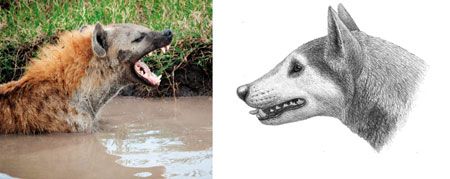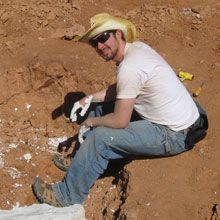New species of bone-crushing dog discovered
It's no jokenewly discovered hyena-like dog fossil sheds light on eastern North America's prehistoric ecosystem

Left, Jo Crebbin/Shutterstock.com. Right, Illustration of Cynarctus by Mauricio Anton from "Dogs, Their Fossil Relatives and Evolutionary History."Steven E. Jasinski, a doctoral student at the University of Pennsylvania and acting curator of paleontology and geology at the State Museum of Pennsylvania, has identified a new species of fossil dog-Cynarctus wangi-according to a Penn Newsarticle.
Named after the curator of the Natural History Museum of Los Angeles County, Xiaoming Wang, C. wangi was originally found under the Choptank Formation in Maryland's Calvert Cliffs region by an amateur collector.
Jasinski and his study partner, East Tennessee State University professor and East Tennessee State University National History Museum at the Gray Fossil Site curator Steven C. Wallace, say the coyote-sized dogs likely lived on the eastern coast of North America 12 million years ago and behaved similar to hyenas.
C. wangi is the first carnivore to be discovered in the Choptank Formation and is an unusual find for the period. “Most fossils from this time period represent marine animals, who become fossilized more easily than animals on land,” Jasinksi says in the article. “It is quite rare we find fossils from land animals in this region during this time, but each one provides important information for what life was like then.”

Steven E. Jasinski, courtesy of Penn News.The fossil dog belongs to the Borophaginae subfamily, an extinct group of canids commonly referred to as “bone-crushing” dogs due to their powerful jaws. According to the article, “Borophagine dogs were widespread and diverse in North America from around 30 million to about 10 million years ago … C. wangi represents one of the last surviving borophagines and was likely outcompeted by ancestors of some of the canines living today: wolves, coyotes and foxes.”
The researchers' work has been published in the Journal of Paleontology.